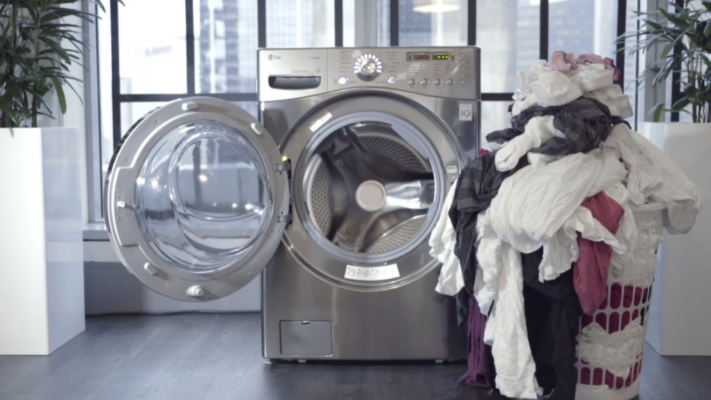What happens if you load more laundry into the washing machine?
Each washing machine has a permissible maximum load. Its manufacturer usually indicates it on the façade and duplicates the information in the instructions. Based on the drum volume and loading, housewives choose the model that suits them. There is an opinion that the more a machine can hold, the better it is. But its durability and high-quality work are affected not only by the capacity of the drum, but also by its rational use.

The content of the article
Exceeding the weight of the loaded laundry
Few housewives know the exact weight of things and measure them before washing. And because of the desire to get through the laundry as quickly as possible, some people load more than is allowed. As a result, a number of unpleasant processes occur with the washing machine:
- due to overload, vibration during spin increases;
- the motor overheats because it requires more power than provided by the manufacturer;
- there is a risk that the laundry does not wash or is not rinsed completely;
- water and electricity consumption increases.
Overheating of the motor in most cases leads to a short circuit. And this is a fire risk. Therefore, manufacturers do not recommend using more weight than indicated in the instructions.

Another important point when loading laundry is that each program has its own permissible maximum load.And usually only the cotton washing mode has a full load. In other cases, it is recommended to pledge a third or half of it.
For delicate wash cycles and woolen items, the manufacturer usually indicates a volume of one third of the maximum. For express washes, it is permissible to load at half the volume. This is due to the fact that the machine is not capable of efficiently washing a large volume in 15–30 minutes.
Calculation of laundry weight before washing
To be sure that the machine is not overloaded, you need to know the weight of things in advance. Modern washing machines have an “auto-weighing” function. With this function, the machine display will indicate the weight of the items loaded into the drum.

If there is no such function in the car, then it is worth remembering or having a reminder with you about how much the main things weigh:
- pillowcase - 200 g;
- sheet - 500 g;
- duvet cover - 700 g;
- bath towel - 500 g;
- tablecloth - 500 gr;
- socks and underwear - from 50 to 200 g;
- blouses and shirts - from 100 to 300 g;
- T-shirt - 150 g;
- jeans - 300–800 g;
- trousers - 200–700 g;
- dress - 300 gr;
- sweater - 150–600 g;
- adult jacket - 900–1700 g;
- children's jacket - 400–800 g;
- robe - 300–500 g;
- children's things - 30–200 gr.
The maximum weight of loaded items and the table below apply to dry items.
Loading the washing machine with less laundry
There are also the opposite situations, when you need to wash 2-3 items that weigh a total of less than 1 kg. Many people are not bothered by this washing option, but loading a small volume also negatively affects the operation of the washing machine.

Firstly, the water and electricity consumption of the machine will still be too high.Modern models with auto-weighing can adjust the flow rate, but it will still exceed the required amount.
Secondly, when loading a smaller amount, the machine will have strong vibration from the empty drum. This also affects the wear of bearings and the motor, as does overload.
And thirdly, the washing machine may simply not understand that things are loaded into it and disrupt the washing cycle. This usually manifests itself as a weak spin or insufficient rinsing. You don’t need to call a technician right away; in most cases, it’s enough just to load more things into the machine.
To avoid problems during the washing process, manufacturers recommend loading at least 1-1.5 kg of clothes into the drum. This guarantees proper operation of the unit and minimal wear of parts.
How to properly load things into a drum
In production, each machine is checked for maximum load. To do this, scraps of thick and dense fabric are placed in the drum so that the weight is maximum or exceeds it. As a result, the drum remains half empty, but loaded to its maximum weight.
But in everyday life, rarely does anyone wash items made from heavy fabrics. Typically, overload occurs from a large amount of bed linen or washing outerwear.

When loading the drum, it is recommended to adhere to the following rules:
- If you need to wash a bulky item (a blanket, a down jacket, a coat), it is loaded into the machine along with a couple of light and small items. If you wash one down jacket, it will bunch up and make it more difficult for the machine to rinse and wash it.
- Even if the total weight of the loaded items does not exceed the maximum, you should not push everything into the drum to the limit. There should be room for free rotation and spin. The machine door should also close easily.
- It is better to wash underwear or other delicate items in special bags. This will reduce wear on the clothes during the spin cycle.
- Before washing, it is better to turn duvet covers and pillowcases inside out and remove large lint and feathers. This will reduce the risk of filter contamination.
- Don't forget about pockets either. Coins, pencils and keys can cause irreparable damage to the drum. Or even paint the thing. It is advisable to fasten all zippers and buttons.
There are no complicated rules for operating a washing machine. It is enough to distribute the washing volume into several approaches in advance, do not exceed the norm and check the items before loading. This will reduce the risk of premature repair work and expenses on purchasing a new car.





